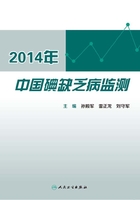
上QQ阅读APP看书,第一时间看更新
全国碘缺乏病监测
2014年度全国碘缺乏病病情监测报告
■ 范丽珺 苏晓辉 申红梅 刘鹏 孟凡刚 李明 刘丽香 刘守军 孙殿军
(哈尔滨医科大学中国疾病预防控制中心地方病控制中心)
摘要 为进一步了解我国碘缺乏病病情变化和防治措施落实现状,评估各省持续消除碘缺乏病的进展情况,掌握《食用盐碘含量》(GB 26878—2011)标准实施后我国居民碘营养状态,并为全国地方病防治“十二五”规划(以下简称“十二五”规划)终期考评提供参考,国家卫生计生委于2014年部署开展了第七次全国碘缺乏病监测工作。本次监测采用“按人口比例概率抽样方法(PPS)”进行抽样,在全国31个省(自治区、直辖市)(以下简称省份)及新疆生产建设兵团(以下简称兵团)的899个县(市、区、旗)共抽取49214名儿童进行甲状腺容积的检测,对48408名儿童进行了家中食用盐盐碘的检测,对48975名8~10岁儿童和19500名孕妇进行了尿碘检测。
2014年全国8~10岁儿童B超法甲状腺肿大率(以下简称甲肿率)为2.6%,山东甲肿率超过5%。全国碘盐覆盖率为96.3%,合格碘盐食用率为91.5%,盐碘均数为24.3mg/kg,加碘盐盐碘均数为25.2mg/kg。31个省份及兵团中22个省份及兵团碘盐覆盖率大于95%,21个省份及兵团合格碘盐食用率达到了90%以上。全国8~10岁儿童尿碘中位数为197.9μg/L,无儿童尿碘中位数低于100μg/L和高于300μg/L的省份,31个省份及兵团儿童尿碘中位数均在100~299μg/L之间,其中19个省份儿童尿碘中位数在100~199μg/L之间,12个省份及兵团儿童尿碘中位数在200~299μg/L之间。31个省份及兵团孕妇尿碘中位数为154.6μg/L,其中18个省份及兵团孕妇尿碘中位数低于150μg/L,13个省份孕妇尿碘中位数在150~249μg/L之间,无孕妇尿碘中位数在250μg/L以上的省份。
本次监测表明,我国碘缺乏病在国家水平上处于消除碘缺乏病状态。具体表现在全国儿童甲肿率为2.6%;碘盐覆盖率为96.3%,合格碘盐食用率为91.5%;8~10岁儿童尿碘中位数为197.9μg/L,尿碘小于50μg/L的比例为4.3%,各项指标满足碘缺乏病消除标准的要求。结合2011年、2005年的监测结果可以看出,我国自2005年以来始终处于可持续消除状态。
本次监测发现,安徽、四川、浙江、山东和山西等25个省份有138个调查点甲肿率超过5%,18个省份及兵团孕妇尿碘水平介于100~150μg/L之间;9个省份碘盐覆盖率小于95%,10个省份合格碘盐食用率小于90%。为此,需要进一步落实突出重点、因地制宜、分类指导的科学补碘策略。本次监测结果提供了《食用盐碘含量》(GB 26878—2011)标准执行后的效果评价数据、“十二五”规划终期考评的参考数据和持续消除碘缺乏病目标的进展情况。
ABSTRACT In order to monitor iodine deficiency disorders(IDD)conditions,acquire the implementation of the prevention measures,evaluate the IDD eliminating progress in each province,handle the iodine nutrition status after the adjustment of standard salt iodine concentration and provide the reference for the evaluation of the Twelve-Five Planning,the seventh iodine nutrition surveillance was conducted by the National Health and Family Planning Commission in China.Probability proportional to size sampling method was adopted to recruit children aged 8~10 years and pregnant women.A total number of 49214 children aged 8~10 years were examined the thyroid volume in 899 counties in 31 provinces and Xinjiang Corps.48408 edible salts in household level were provided by school children.48975 and 19500 urine samples were respectively collected from school children and pregnant women and measured in laboratories.
The national goiter rate was 2.6%in children,and was over the national standard of 5%only in Shandong.The national coverage rate of iodized salt and consumption rate of qualified iodized salt was 96.3%and 91.5%,respectively;the mean of iodine content in salt and in iodized salt was 24.3mg/kg and 25.2 mg/kg,respectively.The provincial coverage rates of iodized salt were over 95%in 22 out of 31 provinces and Xinjiang Production and Construction Corps(Xinjiang Corps),and the consumption rates of qualified iodized salt were more than 90%in 21 provinces and Xinjiang Corps.The national median urinary iodine in children was 197.9μg/kg.The provincial medians urinary iodine were at 100~199μg/L in 19 provinces,and at 200~299μg/L in 12 provinces and Xinjiang Corps.The national median urinary iodine in pregnant women was 154.6μg/L,slightly higher than the lower limit of the WHO criteria for adequate(150~249μg/L).The provincial medians urinary iodine in pregnant women were in the range of 100~149μg/L in 18 provinces,and in the range of 150~249μg/L in 13 provinces.
It was indicated that the IDD was eliminated in the national level.The performance was:the total goiter rate was less than 5%;the use of iodized salt was over 95%;the consumption of qualified iodized salt was above 90%;the median of urinary iodine concentration in school children was between 100~200μg/L;not more than 20%of samples was below 50μg/L.All these results met the requirement of IDD elimination.The IDD was sustained eliminated since 2005.
It was found that:the goiter rates were above 5%in 138 survey points which distributed in 25 provinces;the median urinary iodine concentration was less adequate in 18 provinces and Xinjiang Corps;the coverage rates of iodized salt and qualified iodized salt were under the national standard in 9 and 10 provinces respectively.The 2014 national IDD surveillance provided useful data for assessing the adjustment of the new salt standard and the reference of“the twelfth five year assessment”and important progress for evaluating the IDD elimination.